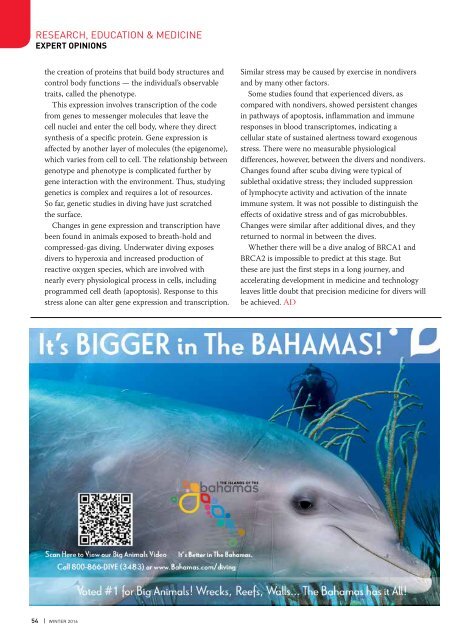AD 2016 Q1
Create successful ePaper yourself
Turn your PDF publications into a flip-book with our unique Google optimized e-Paper software.
RESEARCH, EDUCATION & MEDICINE<br />
EXPERT OPINIONS<br />
the creation of proteins that build body structures and<br />
control body functions — the individual’s observable<br />
traits, called the phenotype.<br />
This expression involves transcription of the code<br />
from genes to messenger molecules that leave the<br />
cell nuclei and enter the cell body, where they direct<br />
synthesis of a specific protein. Gene expression is<br />
affected by another layer of molecules (the epigenome),<br />
which varies from cell to cell. The relationship between<br />
genotype and phenotype is complicated further by<br />
gene interaction with the environment. Thus, studying<br />
genetics is complex and requires a lot of resources.<br />
So far, genetic studies in diving have just scratched<br />
the surface.<br />
Changes in gene expression and transcription have<br />
been found in animals exposed to breath-hold and<br />
compressed-gas diving. Underwater diving exposes<br />
divers to hyperoxia and increased production of<br />
reactive oxygen species, which are involved with<br />
nearly every physiological process in cells, including<br />
programmed cell death (apoptosis). Response to this<br />
stress alone can alter gene expression and transcription.<br />
Similar stress may be caused by exercise in nondivers<br />
and by many other factors.<br />
Some studies found that experienced divers, as<br />
compared with nondivers, showed persistent changes<br />
in pathways of apoptosis, inflammation and immune<br />
responses in blood transcriptomes, indicating a<br />
cellular state of sustained alertness toward exogenous<br />
stress. There were no measurable physiological<br />
differences, however, between the divers and nondivers.<br />
Changes found after scuba diving were typical of<br />
sublethal oxidative stress; they included suppression<br />
of lymphocyte activity and activation of the innate<br />
immune system. It was not possible to distinguish the<br />
effects of oxidative stress and of gas microbubbles.<br />
Changes were similar after additional dives, and they<br />
returned to normal in between the dives.<br />
Whether there will be a dive analog of BRCA1 and<br />
BRCA2 is impossible to predict at this stage. But<br />
these are just the first steps in a long journey, and<br />
accelerating development in medicine and technology<br />
leaves little doubt that precision medicine for divers will<br />
be achieved. <strong>AD</strong><br />
54 | WINTER <strong>2016</strong>









